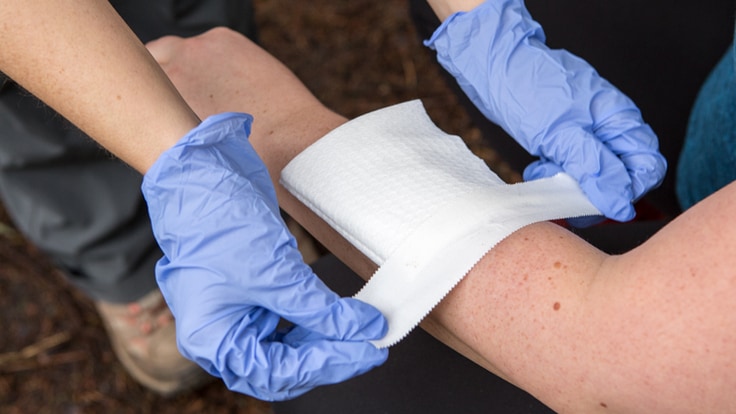A life lived outdoors will inevitably include a few wounds (hopefully only minor ones). Injuries such as little cuts or deeper gouges, minor scrapes or larger abrasions are fairly common among outdoor adventurers, so knowing how to care for them is a good skill to have. Without proper treatment, something as simple as a scraped knee or a little nick on a finger can quickly become infected and require you to head home to see a doctor.
To treat cuts, scrapes and abrasions, follow these general steps:
- Control the bleeding: Apply direct pressure or use a pressure dressing to stop bleeding.
- Clean the wound: Scrub and irrigate the wound to remove contaminants that could possibly cause infection.
- Dress and bandage the wound: Use sterile gauze and a bandage to cover the wound.
- Monitor the wound for infection: Even a minor cut can become infected so you need to keep an eye out and respond quickly if you see redness, pus or swelling at the site of the injury.
The information in this article is taken from NOLS Wilderness Medicine, 6th edition, which is the basis for the curriculum taught by instructors from NOLS. You can take a NOLS Wilderness Medicine course at many REI stores:
Remember: Safety is your responsibility. No article or video can replace the advice of a physician, nor professional instruction and experience. Make sure you're practiced in proper techniques and safety requirements before you render first aid.
How to Control Bleeding
Whether you sliced yourself with your pocket knife or scraped your knee on a rock, the first step in treating a wound is to get the bleeding under control. There are two primary ways to control bleeding: with direct pressure or with a pressure dressing. A third option, using a tourniquet, can help control severe bleeding, but that's not something that will be covered here. To learn how to use a tourniquet, seek out professional medical training.
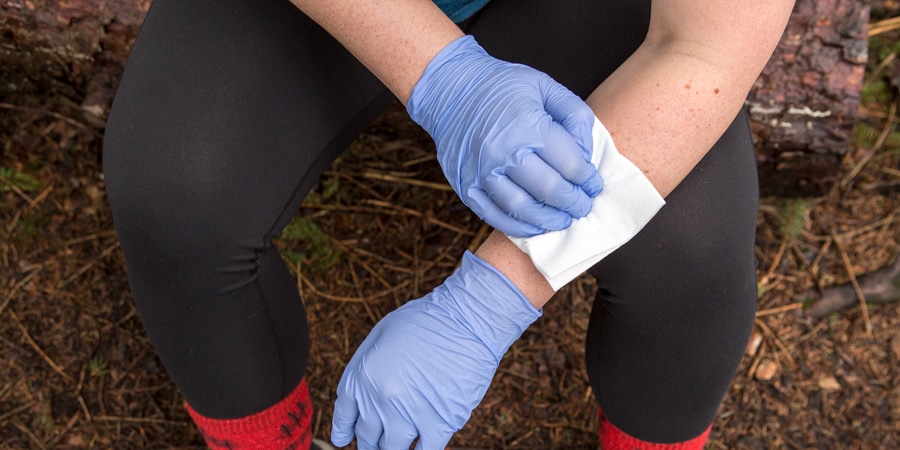
How to apply direct pressure to a wound: Simply applying direct pressure will typically stop most of the bleeding. Here's how:
- Put on medical gloves or slip your hand inside a plastic bag.
- Place a piece of sterile gauze (or a piece of fabric, in a pinch) on the wound and apply direct pressure with your fingers. Focus the pressure on the source of the bleeding.
- For a large wound, you may need to pack it with gauze before applying pressure.
- If the gauze or fabric becomes soaked with blood, leave it in place and apply more gauze or fabric (removing the material can disrupt clotting).
- Elevating the wound while applying pressure can potentially help stop the bleeding. For example, if you get a cut on your leg, lie down and prop your leg up on something.
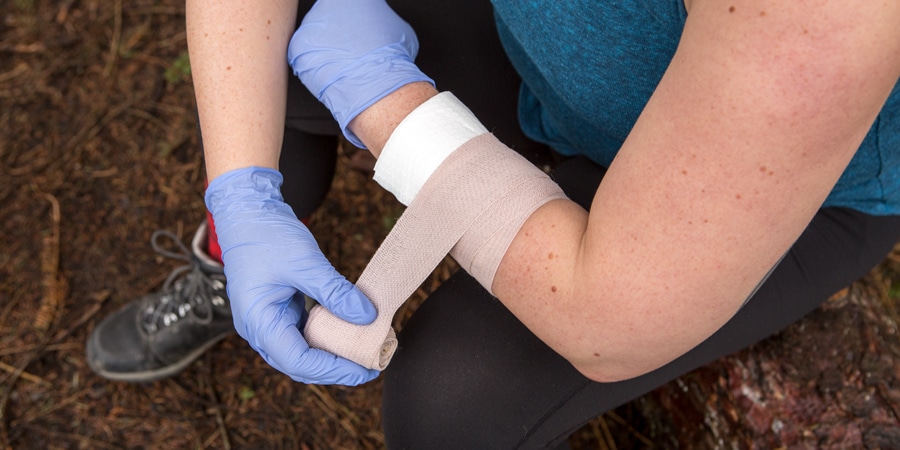
How to apply a pressure dressing to a wound: A pressure dressing is a large dressing that's secured in place on top of the wound to apply pressure and stop bleeding. One of the benefits is that it frees up your hands to work on other tasks. Here's how to create one:
- Put on medical gloves or slip your hand inside a plastic bag.
- Apply sterile gauze pads or a piece of fabric to the wound.
- Wrap the wound firmly with roller gauze, an elastic wrap or a strip of fabric to apply pressure to the wound.
- Check the patient's circulation, sensation and movement to make sure you didn't wrap the dressing too tight. Does the area around the injury still seem to be getting good blood flow? Can the patient tell you where you're touching? Can the patient still move their hand, foot, finger, etc.?
How to Clean a Wound
When you have the bleeding under control, the next step is to thoroughly clean the wound. Take your time and do a good job with this to ensure you remove any contaminants that could possibly cause an infection.
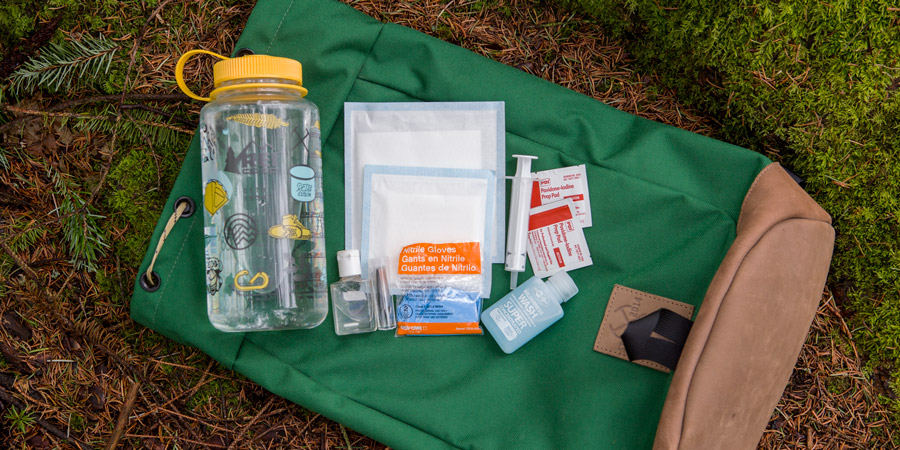
To clean a wound, follow these steps:
- Wash your hands and put on gloves: Thoroughly wash your hands using soap and water to prevent contamination of the wound. If you don't have soap and water, you can use and alcohol-based sanitizer. Then, pull on a pair of medical gloves.
- Scrub and irrigate the wound: Using sterile gauze pads, soap and water, first scrub the skin around the wound, being careful not to push any debris into the wound. You can remove large pieces of debris with tweezers that have been cleaned with povidone-iodine or boiled. Then, irrigate the wound thoroughly with disinfected water. You can disinfect water several ways, including by filtering, using iodine tablets, using chlorine dioxide drops or boiling and cooling. Disinfected water alone is usually adequate for irrigating a wound, but if the wound is obviously dirty or contaminated then use a 1 percent povidone-iodine solution. You can make 1 percent povidone-iodine by mixing one part 10 percent povidone-iodine (found in many first-aid kits) to 10 parts water. A 35cc syringe (included in many first-aid kits) is a good way of pressure cleaning a wound. You should use a minimum of 500ml (17 fl. oz.) of disinfected water for irrigation.
- Rinse with disinfected water: If you irrigated the wound with povidone-iodine, then you'll want to rinse the wound with disinfected water to get rid of any lingering solution (if you irrigated with disinfected water, you can skip this step). Look for new bleeding in case any blood clots were disturbed during cleaning. If so, apply direct pressure again.
How to Dress and Bandage a Wound
With the wound suitably clean, it's time to dress and bandage it. For small cuts, this can be as easy as putting on a simple adhesive bandage. For larger wounds, though, you may need some additional supplies.
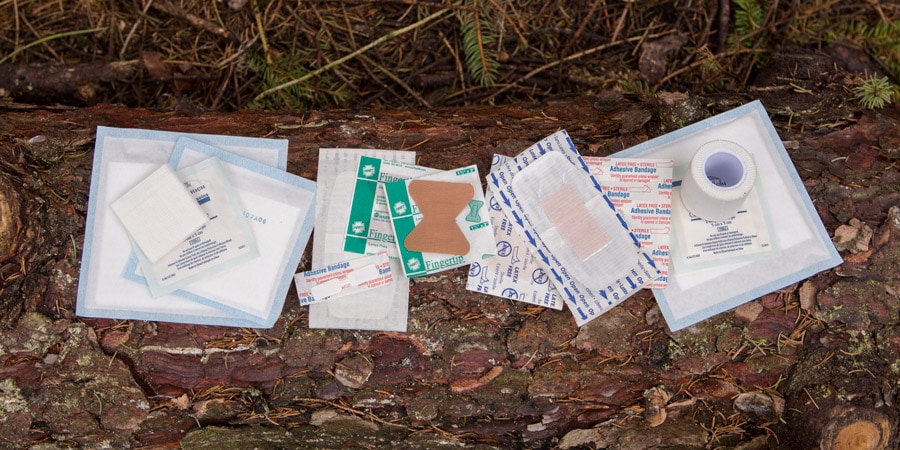
To dress and bandage a wound:
- Pick out a sterile bandage: There are many different types of bandages available on the market to accommodate different types and sizes of wounds. For larger wounds, sterile gauze often works well.
- Apply antibiotic ointment to the bandage rather than directly on the wound. This can help prevent infection and keep the wound moist to promote healing.
- Place the bandage on the wound. For larger cuts and gouges where the edges of the wound are stretched apart, you may need to apply butterfly bandages or Steri-strips across the cut to hold the edges together prior to putting the bandage on.
- Secure the bandage in place: When using a non-adhesive bandage, such as sterile gauze, you need to secure it in place. An adhesive wrap, elastic bandage, roller gauze or waterproof medical tape are all good options.
- Change the dressing daily or more frequently if it becomes wet with blood or fluid. You want to keep the wound clean and moist, not dirty and wet. While changing the dressing, look for signs of infection.
- If the wound is on a joint, consider splinting: For example, if the injury is on a knuckle, you may need to splint the finger to keep the edges of the wound from pulling apart.
- Check CSM: After the wound is dressed and bandaged, check the patient's circulation, sensation and movement around the injury. You can look for signs of good blood flow, ask the patient if they can tell you where you're touching and have the patient try to move the extremity near the injury, such as their hand, foot or finger.
How to Monitor the Wound for Infection
At home, with easy access to clean water and soap, keeping cuts uncontaminated and infection-free is relatively easy. But, in the backcountry it can be more challenging. For this reason, you need to monitor even the smallest cuts very closely.
To monitor a wound for infection:
- Look for signs and symptoms of a mild-to-moderate infection: Keep any eye out for redness, swelling, pus, heat and/or pain at the injury.
- Look for signs and symptoms of a serious infection: These include red streaks radiating from the site, fever, chills and swollen lymph nodes.
If you've recognized the signs and symptoms of a mild-to-moderate infection and it is localized to the site of the wound, then you can provide treatment in the field. A serious infection requires evacuation and treatment by a medical professional.
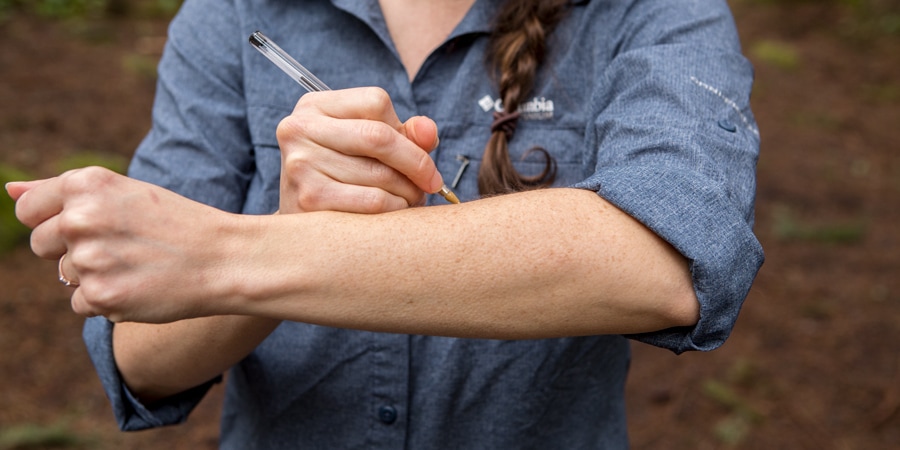
Treatment options if you suspect an infection:
- Soak the injury: Soak the area in hot water for 20 - 30 minutes. Do this three to four times a day.
- Open the wound: If the edges of the wound are closed, pull them apart (if the wound cannot be opened then you need to consider evacuating and getting treatment).
- Clean, irrigate and dress the wound again: If you can't get the wound clean, you can pack the wound open with moist gauze while you evacuate.
- Monitor the signs and symptoms: Take a pen and draw a circle at the perimeter of the redness and/or swelling. If throughout the day you notice the redness and/or swelling spreading past the line, the infection may be getting worse. On the other hand, if the redness and/or swelling retreat, then the infection may be resolving.
- Leave if necessary: Don't hesitate to leave and seek medical help if you're unsure how to treat the problem or symptoms worsen.
When to Evacuate Because of a Cut, Scrape or Gouge
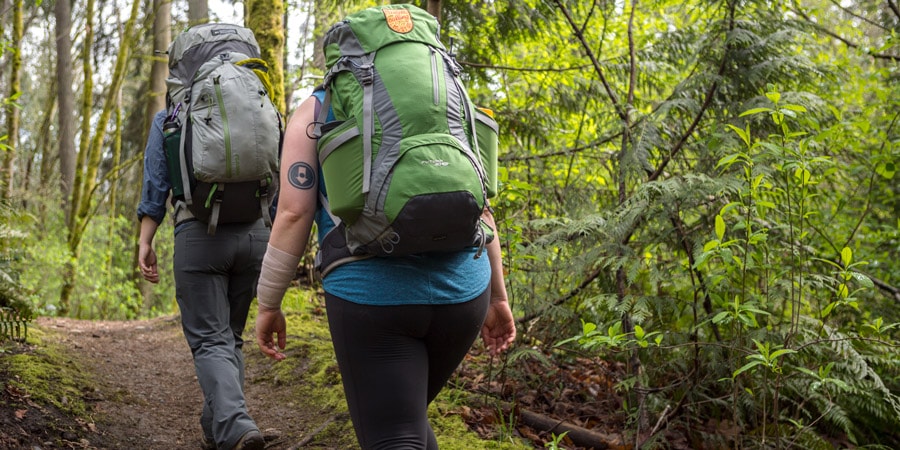
While many cuts, scrapes and gouges can easily be cared for in the backcountry, there are some instances when you should head out and get professional medical care. Some reasons to evacuate include:
- The wound is long and/or deep and you believe it requires sutures.
- The wound contains obvious dirt or contamination.
- The injury is caused by an animal bite (animal bites create heightened concern for infection).
- The wound exposes a joint space (such as a knuckle).
- There are signs of a serious, established infection (fever, chills, swollen lymph nodes or faint red streaks).
- There's a laceration to a cosmetic area, especially the face.
- The wound has lots of dead tissue on the edges or in the wound itself.
- The wound obviously needs surgical care, like an open fracture or a very deep, gaping cut.
In the case of an injury that limits or prevents mobility, you may need to call for help. Cell coverage can be spotty in the backcountry so it's wise to have a backup to a cellphone. Read How to Choose Personal Locator Beacons and Satellite Messengers for two options.
Shop for Satellite Messengers Shop for Personal Locator Beacons
